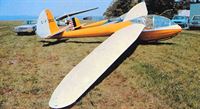
Варианты
- Schweizer - SGS 2-8 / TG-2 - 1938 - США
- Schweizer - SGS 2-12 / TG-3 - 1942 - США
Schweizer. Планеры
Компания "Schweizer Aircraft Company" из Элмира, Нью-Йорк, основана в 1939 году для производства планеров и парашютов. Со временем ассортимент изделий фирмы расширился. В 1960-е годы она строила сельскохозяйственные самолеты, легкие вертолеты, легкие самолеты-амфибии и самолеты-разведчики.
Вероятно, наибольшую известность "Schweizer" принесли планеры, производство которых началось в 1930-е годы. Первые планеры строились в ограниченном количестве, но последующие модели имели большой успех, например, двухместный SGS 2-8 с фюзеляжем из стальных труб и алюминиевым крылом.
<...>
Описание:
- Schweizer. Планеры
- M.Simons The World's Vintage Sailplanes 1908-45
Фотографии
-
Мировая Авиация 232
SGS 2-8, выполнивший первый полет в 1938 году, в авиации Армии США обозначался TG-2, а в ВМС и КМП США - LNS-1. Снимок планера морской пехоты сделан в мае 1942 года.
-
GL / M.Simons - The World's Vintage Sailplanes 1908-45 /Kookaburra/
An interesting photograph taken on 1st September 1979, showing a restored Schweizer TG-2 over the factory at Chemung County Airport, Elmira, where it had been built almost 40 years previously. The color scheme is exactly the same as that used for the military glider pilot training aircraft.
-
GL / M.Simons - The World's Vintage Sailplanes 1908-45 /Kookaburra/
A restored Pratt Read G-I or LNE-1, carrying a Canadian registration. The TG-2 and Kirby Gull 1 are visible in the background.
Другие самолёты на фотографии: Pratt-Read LNE-1 / TG-32 - США - 1942Slingsby T.12 / T.14 / T.15 Gull - Великобритания - 1938
-
Air Enthusiast 2007-03 / B.Norton - Ready for the Silent Assault /World war two/ (1)
A glider pilot recruiting image based on a picture of a Schweizer TG-2 flying over the southern California desert. Such sailplanes seemed a natural starting point for combat glider pilots, but this was soon shown to be misguided.
-
Air Enthusiast 2007-03 / B.Norton - Ready for the Silent Assault /World war two/ (1)
A press day at Twenty-Nine Palms in 1942: a trio of TG-2s stands ready for tow off the dry lakebed adjacent to the field.
-
Air Enthusiast 2007-05 / B.Norton - Ready for the Silent Assault /World war two/ (2)
The US Army's first glider, a Schweizer TG-2, is assembled for flight after being removed from its trailer. A direct copy of a successful civilian competition design, it was contracted for and delivered in the span of three months
-
Air Enthusiast 2007-03 / B.Norton - Ready for the Silent Assault /World war two/ (1)
A staged photo of a civilian instructor and two Army student glider pilots beside a TG-2.
-
Air Enthusiast 2007-05 / B.Norton - Ready for the Silent Assault /World war two/ (2)
Two of the men most influential in the US Army Glider programme was Air Corps chief General 'Hap' Arnold (rear) and Major (soon Colonel) Fred Dent (front). They are trying out the Army’s first glider, a Schweizer TG-2 during September 1941 in New York.
-
Air Enthusiast 2007-03 / B.Norton - Ready for the Silent Assault /World war two/ (1)
Major Fred Dent prepares for a flight with General Hap Arnold (standing) in the US Army's first glider, the Schweizer TG-2. The event was the National Soaring Contest in September 1941 at Elmira, New York, site of the US Army's first glider training.
-
GL / M.Simons - The World's Vintage Sailplanes 1908-45 /Kookaburra/
A restored TG-2 in 1979, in its full wartime paintwork although the front cockpit canopy was a modern moulding. Details of the wing riveting are clearly visible. A simple gap-closing fairing had been taped over the wing root.
-
Air Enthusiast 2007-03 / B.Norton - Ready for the Silent Assault /World war two/ (1)
Three TG-2s are given a triple aero-tow by a Stinson O-49. Such civilian tow-planes were used until Army models were provided.
Другие самолёты на фотографии: Stinson L-1 Vigilant / O-49 - США - 1940
-
GL / M.Simons - The World's Vintage Sailplanes 1908-45 /Kookaburra/
Schweizer SGS 2-8 TG-2
- Фотографии











